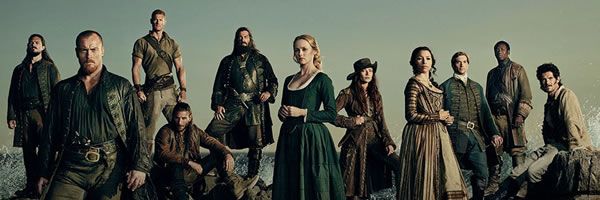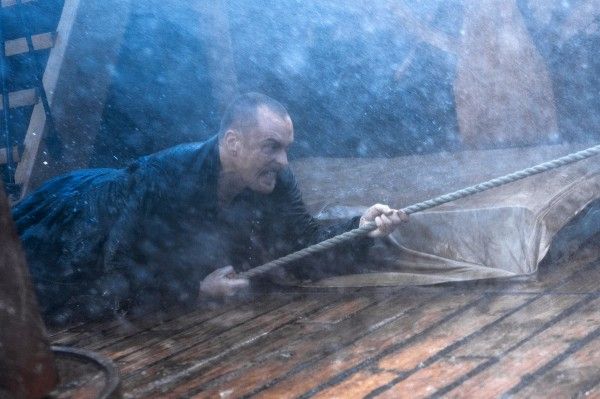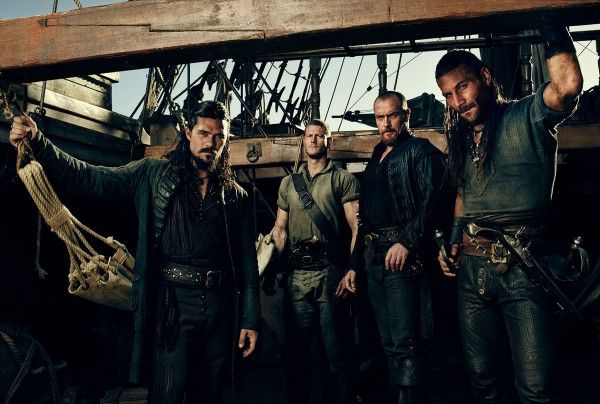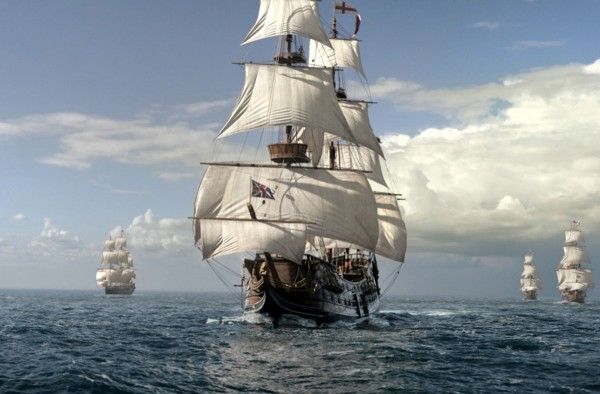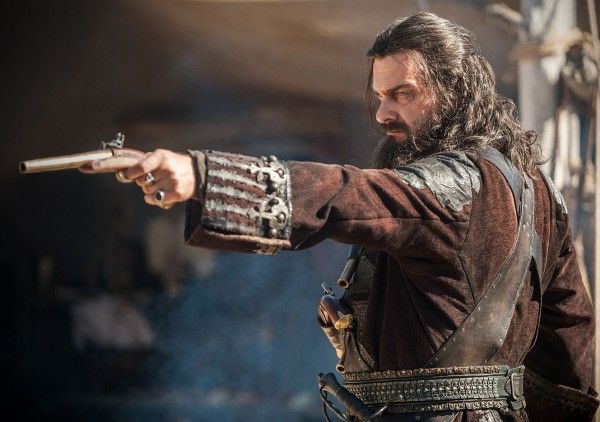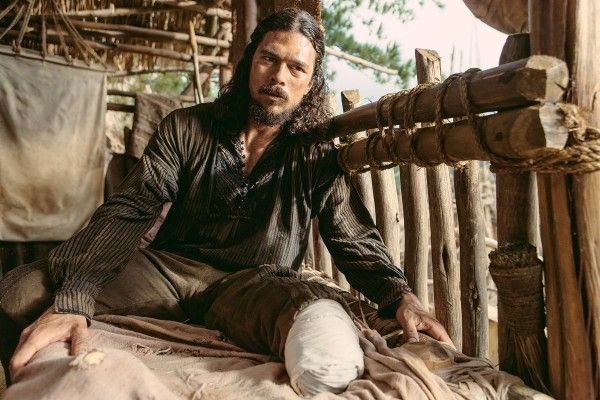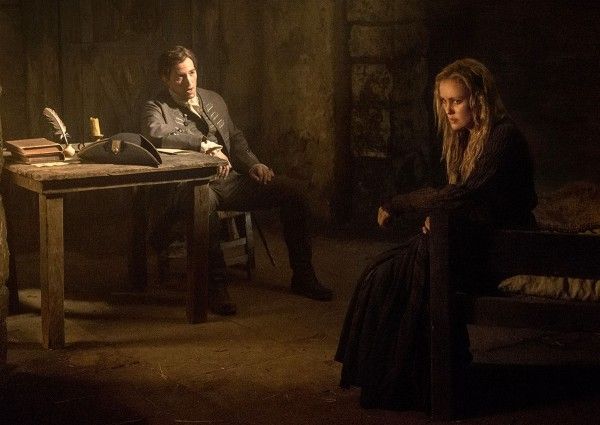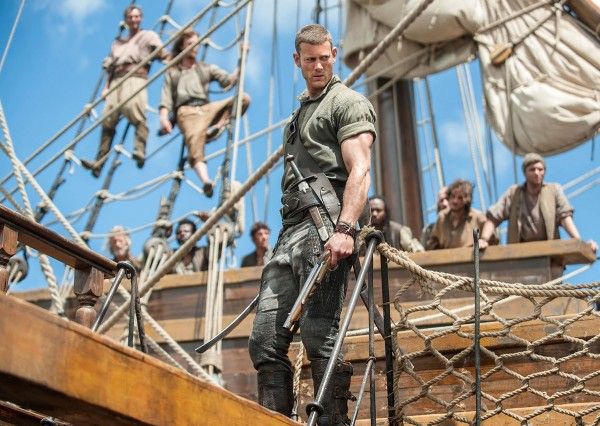From the start, Starz’s Black Sails has been a compelling and exciting tale of what life might have really been like, if you were a pirate, and Season 3 promises to be its biggest and most massive season yet. In the wake of the burning of Charles Town, the New World lives in fear of Captain Flint (Toby Stephens), who’s struggling over whether he’s the pirate myth that he’s created or the man who still lies underneath. At the same time, Eleanor Guthrie (Hannah New) is facing judgment in London, Jack Rackham (Toby Schmitz) is sitting atop a fortune in Spanish gold, and Charles Vane (Zach McGowan) is having to deal with the return of one of history’s most notorious captains, known as Blackbeard (Ray Stevenson). And with Woodes Rogers’ (Luke Roberts) desire to end piracy for good, Nassau will never be the same again.
With Season 3 premiering on January 23rd, there is plenty of time to catch up and binge watch the first two seasons on Starz Play, if you haven’t seen them yet. If you’re a fan who’s awaiting the launch of the new season, or you just want to know what goes into making a show of this size and scope, Collider spoke to showrunners Jonathan Steinberg and Robert Levine for this exclusive interview about the evolution of the story they’re telling and the characters at the center of it.
Here are 15 things that you should know about what it takes to make a show like Black Sails and what you can expect from it in the future.
Looking back to when they started to put Black Sails together, nothing could have prepared Steinberg and Levine for the size and scope that the show is now, and how much bigger it’s gotten since the first season:
JONATHAN STEINBERG: It’s fairly absurd. I don’t think we would have been in our right mind to have had any expectation that production and post-production, equally, would be as massive as they are and that the canvas that we’d be given to draw this on would be as limitless. It’s essentially gotten to the point, especially after Season 3, where nothing is out of bounds. There are almost no stories that are too big to tell. There are some problem-solving exercises, in terms of how to tell them, but it is a new experience for both of us, in television.
ROBERT LEVINE: That’s in large credit to our partners at Platinum Dunes and Starz. None of it would be possible, if they weren’t on the same page with us about what this show should be, and how to deliver on expectations and exceed them. They’ve been committed to that since the beginning, and that’s really what makes it possible.
Some of the sequences on the show are pretty astonishing, but they’ve figured out a way to do everything they’ve wanted to do, as it’s come up:
STEINBERG: We haven’t hit a “No way!” yet. Well, we actually hit a “No way!” last year, but then we decided to do it and it turned out pretty good. There was one sequence, for Season 3, that we felt was too much to dive into to try to bring it to life, and then with Starz’s encouragement, we decided, “To hell with it, let’s just do it!” It’s fun. The idea that you can show almost anything belonged almost entirely to features. Now, in this environment, to be able to tell a story as complicated as this and hopefully as nuanced as this is, and to do it with all the bells and whistles, is unusual. The initial goal, without having any idea of how we were going to get there, was to tell a Deadwood kind of story, as though John Ford made it, without any limits to its scope. That, while sounding ridiculous five years ago, is something we’ve started to grow into and try to really embrace.
When they started doing this show, they kept future storylines and characters in mind that they would be getting to, at some point. It’s been a balancing act between the story they’re currently telling and the story they want to tell:
LEVINE: Part of what got us so excited about starting this story was having read up on the actual history and knowing that there were people like Woodes Rogers waiting in the wings, who are really interesting, compelling characters at the center of a sweeping, massive effort to deal with this piracy issue in the West Indies. If anything, it’s an exercise in restraint, with us wanting to bring him and Edward Teach in sooner, but having to hold back because we already had characters that we were falling in love with and needed to bring to a certain point before these new challenges and personalities entered into it. I think it’s actually worked out really well, in the sense that, now they’re showing up at a time when there’s maximum drama to be milked from it. The idea that Woodes Rogers’ entry is really roped into Eleanor Guthrie’s return to the island was something that couldn’t have happened in Season 1 because she wasn’t in that place yet. But by the time you get to Season 3, it’s actually perfect. Woodes Rogers’ story and Eleanor’s story pays incredible dividends, and you’ll see it when you watch the season. It serves wonderfully, in the sense of adding a new dimension to her story and character, but also allows us to bring history to life in some very specific ways.
STEINBERG: When you read the history about this world, there’s the initial spark of feeling like you’ve been misled about what this world is. There’s so much to the history of it and the reality of it that isn’t a part of Jack Sparrow’s story and isn’t a part of Errol Flynn’s story, and you just want to tell it all. Some of the challenges from our first season was that it was an over-indulgence at the buffet, in terms of trying to share so much of what we found to be fascinating and then finding a pace for it, so that we could tell the story the way we wanted to tell it. There’s stuff in Season 3 that was a part of the Season 1 pitch. We just had to take our foot off the gas a little bit.
They spent two seasons getting viewers to fall in love with their characters, just to set them all up to be in very precarious positions this season:
STEINBERG: We knew, at the outset, there’s an element of tragedy that you can’t get away from, in the sense that I’ve been to Nassau and there are not pirates there anymore. It doesn’t end well for these people. You know it’s going to end badly for most, if not all, of them. It’s just how and when. In telling a story about a world where death was ever-present and was something that they constantly had to grapple with, you want it to be present in the story, too. You want it to feel like these people are mortal. There are costs to the decisions they’re making. Sometimes that means having to do things that suck, as a storyteller, as a producer who’s made friends with these people, and as an audience. You just don’t want to see these people go, but that was the life.
A life of piracy was nearly impossible to survive and be successful at, and this season is really pushing these pirates past the limits of treasure hunting and piracy and into really struggling with what it is to live this way and be an outsider and try to make all of that work:
STEINBERG: While all of these people have come to this world for different reasons, the one thing they all share, in some respect, is a sense of being disenfranchised, and of being outside the system and feeling like the system isn’t built for them. I think there’s a measure of coming to it and just trying to survive. In doing that, it becomes the story we wanted to tell of them trying to figure out what they are. If they’re not of civilization, then what are they? In Season 2, that was very explicitly Flint’s story, in trying to figure out who he was and whether he was this pirate he created or the person he was born as. It’s also told through Anne Bonny’s story, in terms of her trying to decipher her sexuality and identity. And through Season 3, it’s a story that starts to spider out to other characters’ narratives, as they try to figure out who they are and what’s meaningful to them.
The fact that all of these characters are ambitious and out for themselves, above all else, will really est their loyalties and partnerships this season:
STEINBERG: You want for things to constantly be escalating. You want a story that got pretty extreme in Season 2 to find another gear and new sets of stakes that go beyond, “Are we going to get this money or not?” I think what Season 3 starts to become about is that their ideas start to become very dangerous. This idea that Flint is not only proposing but adhering to, in declaring war against civilization, is dangerous. It’s the kind of thing that is a nuisance until it starts to stick, and then it becomes a much more significant threat. So, while all of these individual people have stories of trying to figure out who they are, it is all in the service of trying to figure out what pirates are, how they’re going to be remembered, and what their legacy is going to be, as told by them, before it’s been written in stone and before it’s become, to us, something of a children’s story. It was something else before that. The goal was to get at that story, and to unwind the children’s story and figure out what’s underneath.
LEVINE: It’s about what it was when it was truly dangerous, before it became sanitized, in an entertaining way. People in London where genuinely frightened because the ideas were counter to hundreds of thousands of years of things ingrained and established, as far as norms of power, who benefits and who doesn’t, and who’s worthy of being treated like a human being and who’s unfortunately going to be a loser in the equation.
Now more than ever, the myth of Captain Flint and who the actual man is have merged and are becoming less distinct:
STEINBERG: When Season 3 was a blank white board, we started with, if Season 2 was Flint torn between whether he is what he deems to be his better self in James McGraw, or this monstrous personality he’s created in Captain Flint, then the start of Season 3 is him having completely cast off McGraw and decided that he is the monster. Part of the Season 3 story is the awareness that you can’t do that. While you can’t get rid of the monster, you can’t get rid of the human being either. It’s going to fight for oxygen. It’s going to resist your attempts to make it go away, to deny that you have a conscience, and to deny that you’re having an emotional reaction to the things you’re doing. You can see the human being come back and force its way into the equation. This season is structured as a bit of an odyssey for Flint, and that’s the journey for him. He has to rediscover his humanity and find a place for it, in a world that has already told him it doesn’t want it there.
LEVINE: It asserts itself when it’s grasping for relationships with other human beings. He starts in a place of having lost Thomas Hamilton, who was a very meaningful person to him, and then having lost Miranda in such an awful way that he feels alone. Part of the journey in Season 3 is finding a new person that he feels he can be vulnerable with and be understood by, and it comes from a surprising direction.
With all of the characters on this show and the journeys that they’ve gone through since the beginning, there have been a couple of surprises for the showrunners:
STEINBERG: Because the way we build these stories is organic and real slow, there haven’t been a ton of surprises. Everything has approached the destination we thought we were going to get to, just maybe through paths we didn’t quite see. If there is anyone who his most surprising from where we saw them at the outside, it’s probably Rackham and Bonny, and especially Bonny, who started out slightly unformed, as more of an idea of what we wanted her to be than grappling with who she was. Very quickly, we got interested in her and her story with Max. The idea that it would become an existential crisis about who she is and how she fits in was not part of the initial series pitch.
LEVINE: Thinking back, I feel like a lot of what surprised us came early. I’m thinking about Charles Vane and what he was initially conceived as, which was a rival of Flint and a more brutal breed of pirate. But almost right away, from the first episode, you got a sense of vulnerability there, specifically in his relationship with Eleanor. There was way more to the character than just being a villain, and everything about his story came from that place. It’s interesting how and when they start to really come alive.
With Woodes Rogers wanting to use Eleanor Guthrie to conquer the people she’s been living and working with, it will be challenging for the resident of Nassau to deal with one of their own outwardly turning on them:
STEINBERG: In a constant effort, on our part, to not recycle things or feel like we’re trying to keep people in a dynamic that feels comfortable, these massive shifts and decisions and violence in Season 2 had consequences. We didn’t want Vane and Eleanor to be Ross and Rachel, with that back-and-forth. You could do that, which felt a little dishonest, or you could own that it was never going to be the same between them and that they were going to be enemies after this, in a way that feels more meaningful because of how close they were before and because of how violent and ugly the split was. I think we’re constantly trying to own that. When things turn between these people, they don’t know they’re characters on a TV show that have to get along. These kinds of conflicts are rough and uncompromising.
LEVINE: With any relationship, when it’s working, you see the person that you want to be, or that you think you want to be, through the other person. And then, engaging with that, it either quickly or not so quickly becomes something that you’re almost defined by, so you push off that person into something new. That’s what happens with Eleanor and Vane. She starts to recognize that compromise is something that is just inherent to getting by and surviving in life, and she gets there sooner than he does and a lot of people on the island do, so she benefits from that.
Because they already have such strong, bad-ass group of characters on this show, who all have such compelling backstories, and there is such a great group of actors embodying those characters, it’s challenging to decide which new actors might fit in with this already established cast and really hold their own:
STEINBERG: It’s really hard. There’s also an extra component of complexity that we’re very fortunate to inherit, in the sense that they all get along, as well. It’s a nice, healthy, good, comfortable environment. So, there’s this pressure on us to not mess that up and to try to find people that can embody those roles. Both Ray Stevenson and Luke Roberts, who plays Woodes Rogers, fit right in. With Ray as Edward Teach, he fits an expectation of what that character is, and equally with Luke as Rogers, that’s a character that we’re excited about. He exists in that world. If you know anything about pirates and that universe, you know about him, but I’ve never seen him brought to life like this. That’s been a lot of fun for us.
LEVINE: These characters can’t just be one thing. If you’re casting for someone like Ray Stevenson, then you need to make sure that you’re giving him something that’s worthy of him. Ray brings not just gravitas and physical presence as Blackbeard, but he’s also got this wonderful vulnerability to him that he brings out. We had to make sure that we were communicating that in the material. This is someone who’s going to be many things to many people. That’s something that we aim for with every character on the show.
We learn pretty quickly that Blackbeard is not the same kind of pirate that the other pirates on Nassau are, and he has very different ideas for what will make Nassau successful:
STEINBERG: We wanted Edward Teach, the pirate, to feel like he came from a different time and place. He came from the old neighborhood, and he’s a guy who pirated under a code that feels like it’s being upset and ignored by this next generation of guys who are in charge, which felt like a gangster trope, in a good way. At the same time, it was really important to us that this character didn’t walk into the show as just a villain or as just a presence to stir shit up, but had an emotional place to stand. The story about him, in his former life, having seen Vane as a protégé who saw the world the same way he did and who was almost a surrogate son to him, coming back has made it an estranged father story that felt compelling and felt like it would make him vulnerable. This guy who is invulnerable to all of these people, in terms of physical force and violence, has this massive gaping vulnerability in his need to repair this relationship with Vane. The goal of all of them is to make sure that, whatever else they are, they’re human beings. These aren’t people solely in an adventure. These are people really struggling to get by and understand themselves. That applies even to Blackbeard. The rules are the same.
It’s really easy to take for granted that everything on this show is practical because the effects are so good and so seamless. And while they wish viewers knew just what goes into making the show they see, they also congratulate themselves on a job well done with the effects:
STEINBERG: There is a constant process of congratulating our visual effects supervisor, Erik Henry, on doing stuff that people can’t tell isn’t real.
LEVINE: Same with our crew in Cape Town. It’s just a tremendous effort, on the part of the 200 to 300 people on the crew who deliver these set pieces, and you want them to get their due.
STEINBERG: It’s not just doing these special effects. There’s a massive learning curve to be able to do the water the right way and the sails the right way. There are not a lot of people out there doing 18th century sail work in visual effects, so our guys had to figure it out. Now, in Season 3, their skill set at that has gotten really good. It’s become a pretty regular occurrence where we’ll look at shots and forget that things weren’t there and didn’t really exist. That’s pretty cool. As much as Season 2 got better, as we got better at it, Season 3 is a quantum leap forward in how well the ship work turned out.
Season 3 has a storm sequence that is quite tremendous to watch, and even though they’ve spent two seasons learning how to pull things off on the budget they have, it’s still a decent size budget:
STEINBERG: We were definitely given a fair amount of rope with which to accomplish it or hang ourselves. The storm was the biggest thing we undertook in the third season, as a practical issue, but everyone went in with their eyes open. Starz, production, Lukas Ettlin, who directed the episode, and Erik Henry, who did the special effects, all knew that it was going to be really difficult. Features don’t do this. I’ve seen this done in features where they will skimp on things we chose not to skimp on. We didn’t want there to be stark, broad daylight in the middle of this hurricane because that would undermine it, but that adds a whole other level of complexity when you’re talking about shooting 15 to 20 days in broad daylight that all needs to match, so that you can make the sun go away. All of those elements are a lot to undertake. But at the beginning, we all decided that, if we were going to do this, we wanted to do it the right way and do a definitive version of what this should look like. Once you decide that, it’s just about struggling to keep up and trying to get it done.
If Season 3 turns out to be as big as it’s promising, Season 4 will have a lot to live up to:
STEINBERG: We’re in the middle of that, at the moment. At a certain point, if you care about these people, watching them in any kind of jeopardy feels big, and as the character collisions start happening, they feel big. Season 3 is massive. It’s as big as the first two put together. You go into Season 4 feeling like you have to top that somehow, and we’re trying.
LEVINE: Sometimes just as an exercise in the writers’ room, we try to extrapolate from the story things we haven’t done yet or sequences we can try. You don’t know where they’re going to fit in yet, but you want to keep them filed away in the back of your head for the right moment. There are a couple of them, coming into Season 4, that we’re going to figure out a way to do. We’ve already begun exploring them with the production team and they’re going to be fantastic. It’s a point of pride for this show to be able to do things that you just can’t see anywhere else on TV.
STEINBERG: We never want to do the same thing twice. We never want to see a set piece that’s left over from something we’ve already done. We want to do something absolutely different. In Season 3, the first four episodes are all very big and all very different, in terms of what makes them big. Season 4 is an extension of that.
For people who haven’t tuned in to Black Sails yet, there is plenty of time to binge on the first two seasons before Season 3 starts:
STEINBERG: I think this show has become something special in television, which is a hard thing to say ‘cause there’s so much stuff out there. We set up some pretty massive goals for ourselves, early on, and while it took a minute or two to figure out exactly how to do it, Season 2 turned into something we’re pretty proud of, and Season 3 is a spectacle, in every direction. So, now is as good a time as any to catch up. There isn’t anything on TV like this, at the moment. It’s turned out in a way that we’re pretty proud of.
Black Sails Season 3 premieres on Starz on January 23rd. Season 1 and 2 are available for binge-watching on Starz Play.

